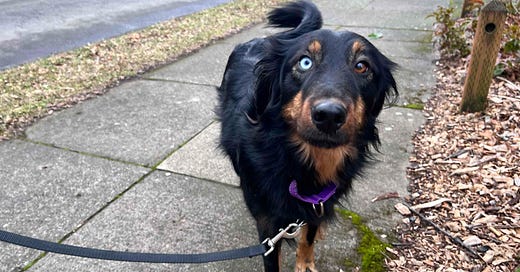Pants was not leash-trained when we adopted her. A three-year-old Aussie mix, she was All About Walks. She pulled so hard that my biceps hurt afterwards. She pulled so hard that sometimes she reared up on two legs (she was fine with this; better view). She was like a bee on a string, except the bee weighs 40 pounds and wants to kill squirrels. She darted from bush to pee spot to weird stain on the ground, pausing only to yodel at a dog across the street. She jumped onto walls and dragged me up to other people’s doors to claim each house as her own. She launched through the neighborhood with the velocity of a fighter jet, leveling up to light speed at the sight of a cat, squirrel, or wind-blown leaf. Walking her was an adventure I didn’t want to go on and couldn’t wait to finish.
Sometimes your mind behaves like Pants. It’ll yank you towards one thought and then ricochet off to another, gathering momentum that feels unstoppable. Usually, your mind waits until you’ve climbed into bed to find every single thing you could possibly worry about and pelt them at you:
Why did I speak up in class? Everyone must think I’m so stupid! I forgot to pay that bill. I’m going to have late fees now. I haven’t heard from my mom today. She must be dead!!
There are lots of philosophies about how to leash-train a dog. The method I used went like this: whenever Pants started going off in her own direction, I turned around and went the other way: “We’re going this way now!”
Pants would re-calibrate, then surge forward again: “YES THIS WAY IS THE BEST WAY!”
As soon as it was clear that she wasn’t paying attention to me, I’d turn around again, heading in the opposite direction. Exuberant Pants was game, throwing herself full-throttle into the new direction. Again, I’d turn on my heel and go back the way we came.
After practicing this a lot, Pants started to get the message: pay attention to Mom. She’s the one who knows where we’re going. She had to notice what I was doing, rather than barreling through the walk with the grace of a freight train.
Just like with leash training, there are lots of ways to train your mind. The first and most important step is simply to notice it, in the same way that I taught Pants to notice me. When the fake apocalypse (fakepocalypse?) is keeping you awake at night, notice it. Name it to yourself. “I’m noticing I’m having the thought that I’m going to fail.” Try to also notice the emotion: “I notice I’m feeling anxiety.”
Now, choose what you want to pay attention to instead. Maybe it’s the body scan or mindfulness app you like to use. Maybe it’s your breath, a book, or a mantra. I can recommend petting your dog.
Whatever it is, imagine your brain like a dog on a leash. You’re not going to yank the leash, because you could hurt your pup. You’re not going to yell at it, because punishment can make things worse. You’re going to treat it like a fun game.
When your brain launches after some new thought or emotion, notice it. Then say, “We’re going back over here now, yay!” and come back to your breath, your app, or your book. Every time your brain follows, you’re going to reward it with a, “Good job!” Inevitably, Pants will see another squirrel and run after it. Your mind may do the same. No worries. Just turn in the other direction. Remind your brain to pay attention to you.
Pants didn’t learn to walk on a slack leash in a day. It’s been three years, and she still sometimes pretends she’s a sled dog (I have no problem with this when we’re going up hills). It will also take time for you to learn the skill of redirecting your mind, so be patient with yourself. Your mind has been walking you for a long time. It’ll take a minute to retrain it. If you feel impatient, notice that experience. When you notice your mind is walking you, you take the first step to learning how to walk your mind.










Love this. Just found your newsletter—very creative. I just wrote about walking the dog’s yesterday ☺️
https://deerambeau.substack.com/p/adventures-in-dog-walking
A perfect analogy!